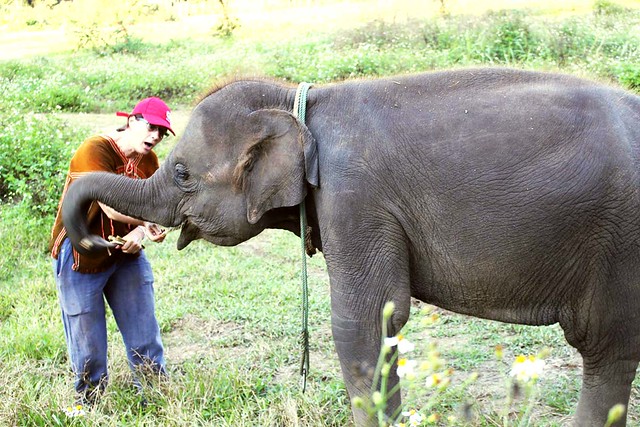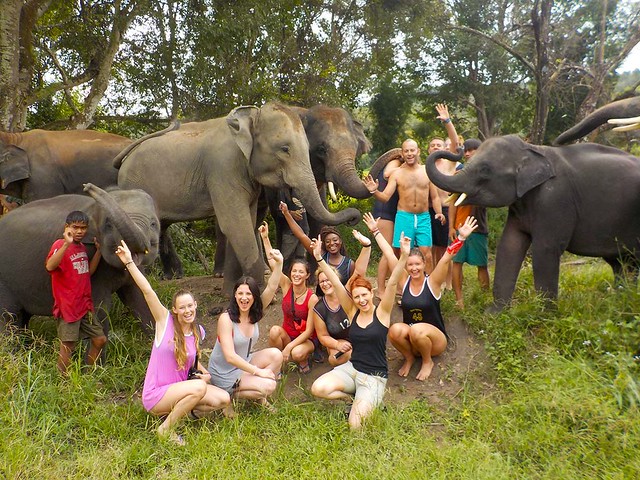

- Visiting the elephant sanctuary in Chiang Mai is a must-do experience for many tourists visiting Thailand.
- Ethical elephant sanctuaries rely not just on the dedication of their caregivers, but also on responsible tourists and visitors.
- Before your visit, take some time to learn about elephants. Understanding their natural behaviors and needs will help you interact with them in a respectful and stress-free way.
1. Thailand’s Enduring Bond with Elephants

Elephants have been an important part of Thailand’s history. For centuries, these gentle giants have played a crucial role in shaping the nation’s identity. They participated in battles and important events, helped build friendly relations between countries, and served as a means of transportation.
This strong connection between Thailand and elephants goes beyond their practical uses as they are also deeply integrated into Thailand’s economic and spiritual beliefs. Elephants have been a constant presence throughout the nation’s main institutions, including the state, religion, and the monarchy.

Elephants have been revered in Thailand for centuries. Today, their role has shifted to tourism, but their cultural significance remains.
2. Thailand’s National Animal
In Thailand, elephants with lighter skin and markings, called “chang phueak” by the locals, hold a special place. These revered creatures are seen as a symbol of the king’s power and good fortune for the entire country. This respect for white elephants goes so far that in 1963, Thailand officially declared them a national symbol.
3. Honoring Elephants in Thailand

Every year on March 13th, Thailand celebrates National Thai Elephant Day, also known locally as Chang Thai Day (วันช้างไทย). Established in 1998, this day is dedicated to raising public awareness about the importance of elephants in Thai culture.
If you happen to be at an elephant sanctuary on National Thai Elephant Day, you’ll get to see a special sight: a giant feast laid out for the elephants, piled high with their favorite fruits. Many of these fruits are actually donated by the public. Donating to the elephants is a way for Thai people to make merit, which means gaining good karma through acts of generosity and kindness. It’s seen as a way to contribute to their own spiritual growth and well-being.
4. Finding Wild Elephants in Thailand

Thailand has set aside 69 protected areas throughout the country to be homes for wild elephants. While you might not see them in northern regions like Chiang Mai, there are places in Thailand where you can observe these magnificent creatures in the wild.
Two of the most popular national parks for elephant watching are Khao Yai National Park and Kui Buri National Park. These parks offer visitors the chance to see wild elephant herds roaming within their natural habitat, although sightings are from a safe far distance.

Elephant herd were spotted crossing the road at Khao Yai National Park.
5. Wild & Captive Elephants in Thailand
Today, Thailand is home to an estimated population of 3,000 to 3,500 wild elephants. These elephants roam freely across 69 protected areas throughout the country.
Additionally, there are approximately 4,500 captive elephants registered and microchipped in the country. Elephants can be found in various captive facilities such as the elephant sanctuaries, usually under veterinary supervision.
While there are reasons to avoid supporting interactive elephant tourism, the issue is not entirely straightforward. Most captive elephants can no longer survive on their own in the wild. These animals require ongoing care, including food, exercise, and veterinary attention. Unfortunately, providing for these needs can be very expensive for their owners.
6. A Second Chance for Thailand’s Elephants

In 1989, the Thai government made a crucial decision to close its forests and ban logging activities. While this was a positive step for the environment, it had an unintended consequence for the country’s elephants.
Many elephants that previously employed in the logging industry were suddenly out of work. This led to a heartbreaking sight – stray elephants wandering through towns and cities, searching for scraps of food amidst bustling traffic. Some were even seen with their mahouts foraging through garbage piles in deserted areas.
However, this situation has slowly improved thanks to the establishment of animal welfare laws. These laws classify elephants as “protected wild animals,” requiring owners to register them which ensures responsible ownership. Additionally, efforts have been made to relocate these elephants to sanctuaries where they can live a semi-captive life under more humane conditions.
7. Elephant Conservation in Chiang Mai & Northern Thailand

Chiang Mai and Northern Thailand are among the world’s most popular destinations for visiting elephant sanctuaries.
The Northern Thailand region, consisting of the provinces of Chiang Mai, Chiang Rai, and Lampang, is home to more than 50 elephant care centers. These includes the elephant sanctuaries, elephant conservation centers, and even the elephant hospitals.
Additionally, some facilities train mahouts i.e. the elephant caretakers, in ethical and responsible elephant handling practices.

The Elephant Hospital inside the Elephant Conservation Center in Lampang.
8. Sanctuaries For Rescued Elephants
The elephant sanctuaries in Chiang Mai and Northern Thailand provide a safe and healthy environment for elephants to live. When healthy and well-fed, female elephants can even mate and raise offspring. Over a typical lifespan of 60-70 years, a single elephant can have 3-5 calves, contributing to a healthier elephant population.
There are still challenges, however. The elephants overall well-being requires long-term, comprehensive solutions. This means ongoing efforts and collaboration from all sectors of society. Ultimately, the goal is to create a harmonious balance where ecosystems, wildlife, and humanity can coexist peacefully.

Over an elephant’s average lifespan of 60-70 years, a healthy female can produce up to 3-5 offspring.
9. The Vital Bond: Mahout and Elephant

The mahout i.e. the elephant caretaker, plays a crucial role in the life of an elephant. They develop a deep understanding of the elephant’s individual personality and temperament, a bond that strengthens over the course of the elephant’s life.
Ideally, each elephant should have its own dedicated mahout, ensuring consistent care and a strong relationship. Unfortunately, this isn’t always possible, and some mahouts may be responsible for caring for as many as six or seven elephants at a time.
The mahout’s role extends far beyond simple caretaking. Their deep understanding of elephants makes them invaluable assistants to veterinarians. They can not only identify potential health problems but also act as interpreters, communicating the elephant’s needs and anxieties to the vet. This unique partnership ensures the well-being of these majestic animals.
10. How Elephants Stay Cool

The elephants, which is the largest land mammals on Earth, are warm-blooded animals. This means they need to regulate their body temperature to stay healthy. Since they live in hot climates, finding ways to cool down is essential for their survival.
One of the most important resources for elephants is shade. They seek shelter under the broad canopies of trees, escaping the intense heat of the sun.
Another crucial element for elephant well-being is water. Elephants consume a significant amount of food daily, roughly 10% of their body weight! This large intake generates a lot of internal heat. To counteract this, they need to drink at least 200 liters of water per day! This water not only keeps them hydrated but also helps regulate their body temperature.

The elephant sanctuaries are always located near a river to allow the elephants to drink freely and cool themselves down.
This explains why elephant sanctuaries are strategically located near rivers. These rivers serve as a reliable source of clean drinking water, allowing elephants to meet their daily needs. Beyond just drinking, elephants also use water for another cooling technique: mud baths! They love to wallow and splash in the mud, coating their large bodies with a cool, wet layer. This mud acts like a natural sunscreen, protecting their skin from the sun’s harsh rays and helping them stay cool.
Interactions with tourists can sometimes be stressful for elephants, leading to a rise in body temperature. After such encounters, they’ll instinctively seek out ways to cool down and relax. Finding shade under trees or taking a refreshing dip in the water becomes their top priority.
11. Responsible Elephant Encounters: Putting Elephants First

When it comes to visiting elephant sanctuaries, choosing an ethical experience is crucial. The best sanctuaries prioritize the health and well-being of the elephants, letting their natural behaviors guide tourist interaction.
Instead of watching trained elephants perform tricks, you could participate in their daily routine. This might involve helping prepare their food and observing their teeth for any health concerns while feeding them.
Exercise is also important for elephants. Walks alongside them, not forcing them, can be a great way for visitors to witness their natural movements and observe them reaching for water sources. Elephants need a lot of water to regulate their body temperature, so these walks can be particularly educational.

Walking with the elephant to their water source is a great way to interact with the elephant as they need exercise and at get hydrated.
It’s important to avoid experiences that exploit elephants for entertainment. Activities like elephant football or bipedal walking are not natural behaviors and can be harmful. Similarly, avoid sanctuaries that showcase wounded or old elephants to evoke pity. These animals need rest and a peaceful environment, not constant interaction with visitors.
By choosing ethical elephant sanctuaries, we can ensure the elephant receive the care they deserve while learning more about their fascinating lives.
12. Respecting Elephants at Sanctuaries

Ethical elephant sanctuaries rely not just on the dedication of their caregivers, but also on responsible tourists and visitors. While your financial contribution through entrance fees directly supports the elephant’s well-being, there’s more you can do to ensure a positive experience for both you and the elephants.
Understanding the elephant’s natural behaviors and needs will help you interact with them in a respectful and stress-free way. This means avoiding any actions that might frighten or upset the elephants, such as bullying or teasing them.
Gentle touches are sometimes permitted, but always ask the mahout for guidance first. They can advise you on the elephant’s personality and whether it’s comfortable with interaction.

For a safe and enjoyable experience for everyone, it’s essential to follow the mahout’s instructions when visiting the elephant sanctuary.
It’s important to remember that elephants, even in sanctuaries, are wild animals and their behavior can be unpredictable. While they may be well-behaved around visitors with their mahout present, they can become easily stressed and still need their space.
Therefore, always follow the mahout’s instructions. Additionally, avoid approaching any elephant that appears to be resting or relaxing on its own. These elephants might not be receptive to interaction and could react defensively if approached.

By following these simple guidelines, you can contribute to a positive and enriching experience for both yourself and the elephants at the sanctuary.

























